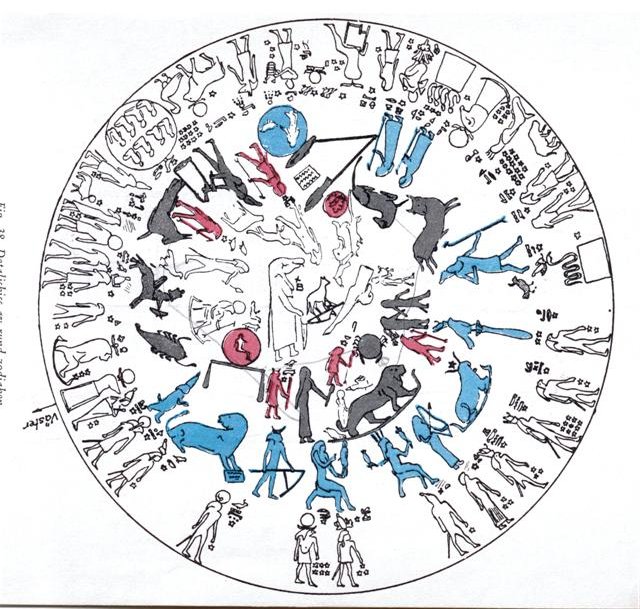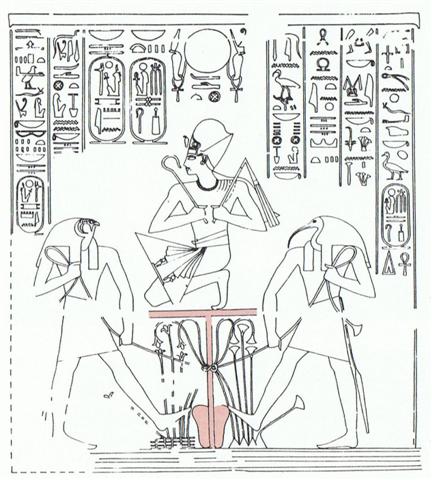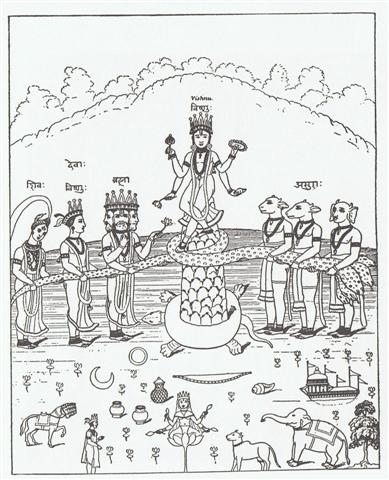|
We have earlier discovered that the first half of the year is like an 'raw and uncultivated beast' and only after the time of 'initiation' ('noon') is a habit of human nature acquired. The 'beast' needs to be 'cooked'. Cfr for instance at vaha kai, where 'the major event of the year' was discussed, and where I suggested 'half-cooked' to be a proper description for the summer half of the year:
The tug-of-war between summer and winter can be illustrated as a struggle between 'beast' on one side and 'men and gods' on the other:
Puaka-tiki can be interpreted as the 'head' (chief) of the season of the beast. The 5-fold head end of the serpent rope in the picture above belongs to the side of the beasts, and the 3rd of the beasts has begun to turn his head towards us (probably a sign of summer solstice being immediately 'ahead').
Puaka-tiki does not eliminate the interpretation in Barthel 2, that Pua-katiki means 'flowers arranged like an aura'. On the contrary, it supplements it, which we can see from the top goddess above, who is showing us an 'aura' sign with her higher hand (on the side of the beasts). In the Dendera round zodiac puaka tamaroa (so to say) is covering, it seems, the bluemarked sign which could have been there in front of Orion (which would increase the number of blue signs to 13):  The time of the year in the Golden Age was early after winter solstice (at Pisces). Nowadays Taurus has advanced forward in the year and together with the 'rainy' Pleiades and Orion will be rising heliacally in early summer (cfr at ragi):
The X form of Orion is here oriented, close to the equator, with one half at left (north) and one half at right (south), and the constellation is not standing up like an hourglass. The north and left halves will correspond to winter respectively summer as seen from Easter Island. The Pleiades are hidden in the rays from the rising sun in May, cfr at maitaki. Could this be the invisible missing 'blue' sign? Taurus is the 'garment' of Sun at that time. I here remember from Allen: "... The Hindus called the moon «acin, or Şaşānka, Marked with the Hare, from the story told of Sakya muni (Buddha). This holy man, in an early stage of his existence, was a hare, and, when in company with an ape and a fox, was applied to by the god Indra, disguised as a beggar, who, wishing to test their hospitality, asked for food. All went in search of it, the hare alone returning unsuccessful; but, that he might not fall short in duty to his guest, had a fire built and cast himself into it for the latter's supper. In return, Indra rewarded him by a place in the moon where we now see him ..." From our experience in reading myths we can guess that the event was a conjunction of Moon (water) and Sun (fire). If the hare (Moon) really threw himself (how difficult it is to avoid saying 'herself') on the fire it would 'kill' the fire and the result would be smoke. The Polynesians saw the dark moon night as an event in which Moon took a revitalizing bath in the pool of the Sun. The peculiar head in Ha5-19 could be an illustration of how new Moon is in front of the sun:
But when in the Dendera zodiac puaka tamaroa is placing himself in front of a possible (not visible) bluemarked sign, it should rather be a sign that the season of Moon (winter) is vanquished. Likewise, if we read clockwise we can interpret the V of Pisces as a way to illustrate how Moon (2 separate fishes) are joining in order to become the staff of the Sun. |







